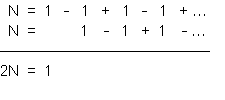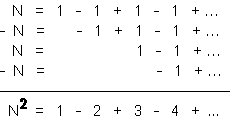About a year ago, when I was a novice blogger, I posted a piece called “A Little Arithmetic”. The arithmetic all looked fine in my browser, but I failed to realize that it might not look fine in everyone’s. As a result, some of you found it unreadable. But I like to think it was worth reading, so now that I’ve figured out how to make it look nice, I’m posting it again:
The mathematician John Baez has been dazzling science lovers on the web for over 15 years with his weekly Finds in Mathematical Physics. (He was a blogger long before there were blogs). Baez recently gave a lovely series of talks on his favorite numbers (they are 5, 8 and 24) in which he mentions Euler’s observation that if you sum up all the positive integers (1 + 2 + 3 + 4 + …) you get -1/12. (I promise, this is not a joke.)
Baez’s “proof” uses a little calculus, but I’ve reworked it into a form you can share with your middle schoolers—and better yet, have them share with their teachers.
Step One. Let’s compute something easier, like 1 – 1 + 1 – 1 + 1 … . Start by making up a name for this sum; let’s call it N. If we add N to itself—and if we line up the columns in the right way — we get 1:

So that tells us that N = 1/2.
Step Two. Now let’s try squaring N. We want to compute N times N, which we can write as N(1-1+1-1+1-1+…) = N-N+N-N+N… and here’s that computation:

But we already know that N=1/2, so this tells us that 1-2+3-4+… = (1/2)2 = 1/4.
Step 3. Now let’s turn to the sum we’re really interested in; 1 + 2 + 3 + 4 + … . Call this M. Then 4M = 4 + 8 + 12 + 16 + … . And if we line things up right and then subtract, we get

In other words (using Step Two), -3M = 1/4, whence M = -1/12. Voila.
Now of course, as your child’s middle school teacher will insist, there’s nothing legitimate about any of this; if you line up your columns right, you can prove anything at all. What’s remarkable, though, is that Euler had phenomenal instincts about how to line up his columns. There is a very deep sense in which -1/12 is exactly the right answer to this problem. Here is a hint of why (warning: this link is WAY too technical for your middle schooler, and for almost everyone else).
Nor is this a purely mathematical game; the physical world seems to care about such calculations. When you try to calculate the energy in, say, a tiny vibrating string, you tend to come up with answers like 1+2+3+4+… You might say “that’s infinite”, but the notion of infinite energy sounds like nonsense to a physicist. On the other hand, an energy of -1/12—well, you might think that sounds like equal nonsense. Strangely, though, you’d be wrong. By taking such results seriously, physicists have been led to deep and meaningful theories. (If you have a taste for advanced mathematics, you can learn more about this in Baez’s talk or the associated slides.)
And so we have one more example of the (apparently) unreasonable effectiveness of pure mathematics —indeed, mathematics at its purest—as a description of the physical world—a recurring theme in The Big Questions.



I’m trying to think about how I would talk to a middle schooler (or, harder yet, their teachers) about this arithmetic.
I can imagine asking them to think about a finite number of terms in this series:
M(k) = 1 + 2 + 3 + 4 + … + k
(k is a positive integer)
I’d be very comfortable showing them that a compact way of writing this sum is:
M(k) = k(k+1)/2.
What would you recommend to say at this point, then, to help them understand the sense in which M(k) is equal to -1/12 if you let k grow to infinity?
(Again, I’m thinking about explaining this to a middle schooler and their teacher. As you point out, the tricks you use here are hard to justify because other seemingly similar tricks yield different answers. But the point of this problem is much more important than showing how to ‘prove’ that 2 = 4.)
As an aside, if I talked with them about the sum:
N(k) = 1 – 1 + 1 – 1 + … + (-1)^(k-1)
I could show them that
N(k) = [1 + (-1)^(k-1)]/2
which is 1 for odd values of k and 0 for even values. Telling them, then, that we will define the sum as equal to 1/2 for infinite k might seem reasonable in the sense that 1/2 is the average of 0 and 1.
I’m not disputing the importance of saying that
M(k) = k(k+1)/2 -> -1/12,
I’m just curious about the suggestion that this is something to share with middle schoolers and teachers. Is there a way to help them understand this in the context of middle-school level arithmetic?
This is why I love maths. Thanks for posting.
I guess I don’t understand. The Riemann zeta function is very cool, but I really don’t see the point if you don’t bring in the complex plane and analyticity.
Divergent series can be manipulated to give lots of funny answers.
I don’t see the need to show this to a middle school teacher who barely understand basic algebra!
I wonder whether your punchline as stated is really your punchline. The sum of all positive integers is not -1/12, so what is the real point of this post?
I’m trying to think about how I would talk to a middle schooler (or, harder yet, their teachers) about this arithmetic.
I can imagine asking them to think about a finite number of terms in this series:
M(k) = 1 + 2 + 3 + 4 + … + k
(k is a positive integer)
I’d be very comfortable showing them that a compact way of writing this sum is:
M(k) = k(k+1)/2.
What would you recommend to say at this point, then, to help them understand the sense in which M(k) is equal to -1/12 if you let k grow to infinity?
(Again, I’m thinking about explaining this to a middle schooler and their teacher. As you point out, the tricks you use here are hard to justify because other seemingly similar tricks yield different answers. But the point of this problem is much more important than showing how to ‘prove’ that 2 = 4.)
As an aside, if I talked with them about the sum:
N(k) = 1 – 1 + 1 – 1 + … + (-1)^(k-1)
I could show them that
N(k) = [1 + (-1)^(k-1)]/2
which is 1 for odd values of k and 0 for even values. Telling them, then, that we will define the sum as equal to 1/2 for infinite k might seem reasonable in the sense that 1/2 is the average of 0 and 1.
I’m not disputing the importance of saying that
M(k) = k(k+1)/2 -> -1/12,
I’m just curious about the suggestion that this is something to share with middle schoolers and teachers. Is there a way to help them understand this in the context of middle-school level arithmetic?